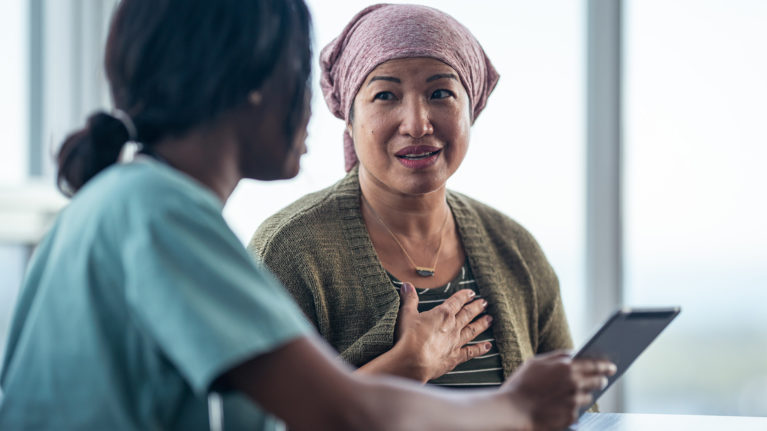This One’s for the Guys: How Breast Cancer Impacts Men

Mathew Knowles is a music executive and the father of two famous women in the music industry: Beyoncé Knowles-Carter and Solange Knowles. He publicly announced his stage four breast cancer diagnosis in an interview with “Good Morning America” co-anchor Michael Strahan.
“I noticed because I wear white T-shirts. I had a dot of blood on my T-shirt … Fast forward, I go to my doctor, and I say I’d like to get a mammogram. He suggested I get a mammogram, but first he said, ‘Let’s get a smear,’” said Knowles in the interview. “So they got a smear of the blood, and it was nonconclusive. Then we got a mammogram and that’s when we saw that, in fact, there was breast cancer there. At least they thought. The next step is to get an ultrasound and a needle biopsy. That’s when they determined it for sure—I had breast cancer.”
How Breast Cancer in Men Happens
Breast cancer can affect *anyone* with breast tissue—yes, that means men! It might seem odd to worry about breast cancer in men, or even a little uncomfortable to talk about, but it’s important to be informed. That’s why we’re here to give you the facts and stats on what men need to know about this disease. Having these conversations could save your life.
Men having breast tissue isn’t something we think about too often, right? We tend to put the focus on women when it comes to breast cancer, but men’s health is impacted as well. The reality is that cells in nearly any part of the body can become cancer and spread to other areas.1 Breast cancer starts when cells in the breast (which men also have!) begin to grow out of control.1
Breast cancer doesn’t always start from the same part of the breast. Most breast cancers begin in the ducts that carry milk to the nipple (ductal cancers), and some start in the glands that make breast milk (lobular cancers).1 Did you know men have these ducts and glands, too? Even though they aren’t normally functional, there’s still a risk of developing breast cancer.1 Here’s a great source to learn more about the different types of breast cancer in men.
What Are the Risk Factors for Breast Cancer in Men?
In 2022, it’s estimated about 2,710 new cases of invasive breast cancer in men will be diagnosed and about 530 men will die.2 So, what exactly are the risks you need to know about? Let’s preface this by saying just because you have the risk factors, doesn’t mean you’re going to get breast cancer. On the other hand, if you have no risks? You’re not totally in the clear, either.
- Family history plays a big role. About 1 out of 5 men with breast cancer have a close relative (male or female) with the disease.3
- Men with BRCA2 and BRCA1 gene mutations have an increased risk of breast cancer.3 These mutations are normally found in family members with many cases of breast or ovarian cancer, but it’s important to keep in mind they’re also found in men with no family history.3
- Men with Klinefelter syndrome are more likely to get breast cancer than other men. Having this condition can increase the risk anywhere between 20-60 times the risk of a man in the general population.3
- If you’re a heavy drinker, you’re at a higher risk of breast cancer because of its effects on the liver and the important role it plays in balancing your sex hormone levels. Men with liver disease can also have a higher chance of developing benign male breast growth (gynecomastia) and a higher risk of developing breast cancer.3
- Certain testicular conditions, such as having an undescended testicle, or having one or both testicles surgically removed, may increase male breast cancer risk.3
- Another unfortunate fact? Black men with breast cancer tend to have a worse prognosis.2
Men Are Opening Up About Their Experience With Male Breast Cancer
Two-time cancer survivor Jacob Bryson has also opened up about his male breast cancer diagnosis in an article for the Breast Cancer Research Foundation. When he felt a lump on his pec, his doctor told him it was a benign cyst. Playing it safe, he opted to have the cyst removed … and THEN found out he had breast cancer. He didn’t have the easiest time with the diagnosis.4
“Basically I felt like I was alone,” Bryson said. He kept his diagnosis, treatment, and recovery private.4 He hopes his story can educate other men and encourage them to be more aware of male breast cancer. You can read more about Bryson’s story here. And if you’re a man with breast cancer feeling the same sense of loneliness, here’s a great resource to help you know you’re NOT alone.
Disclaimers: The content in this piece is for information purposes only and is not intended to be medical advice. Please contact your medical professional for specific advice regarding your health and treatment. This information may be relevant in the U.S. and other markets and is not intended as a product solicitation or promotion where such activities are prohibited. Because Hologic materials are distributed through websites, eBroadcasts and tradeshows, it is not always possible to control where such materials appear. For specific information on what products may be available in a particular country, please write to womenshealth@hologic.com.
The Genius® 3D Mammography™ exam (a.k.a. Genius® exam) is acquired on the Hologic® 3D Mammography™ system and consists of a 2D and 3D™ image set, where the 2D image can be either an acquired 2D image or a 2D image generated from the 3D™ image set. The Genius® exam is only available on the Hologic® 3D Mammography™ system. Please consult your physician for a complete list of benefits and risks associated with mammography.
Hologic, 3D, 3D Mammography, Genius, The Science of Sure, and associated logos are trademarks and/or registered trademarks of Hologic, Inc. and/or its subsidiaries in the United States and/or other countries. Copyright© 2022.
-
1. What Is Breast Cancer in Men? American Cancer Society. https://www.cancer.org/cancer/breast-cancer-in-men/about/what-is-breast-cancer-in-men.html. Accessed Feb. 27, 2022.
2. Key Statistics for Breast Cancer in Men. American Cancer Society. https://www.cancer.org/cancer/breast-cancer-in-men/about/key-statistics.html. Accessed Feb. 27, 2022.
3. Risk Factors for Breast Cancer in Men. American Cancer Society. https://www.cancer.org/cancer/breast-cancer-in-men/causes-risks-prevention/risk-factors.html. Accessed Feb. 27, 2022.
4. Male Breast Cancer Survivor Shares his Story to Alleviate Stigma. Breast Cancer Research Foundation. https://www.bcrf.org/blog/male-breast-cancer-survivor-shares-his-story-alleviate-stigma/?utm_source=google&utm_medium=cpc&gclid=CjwKCAiAgvKQBhBbEiwAaPQw3AYQ0duh_Ob-r22O-Ozo7RcYA1OD9k8iJaoQXcPUyDKh8U1VxCkcBRoCPXQQAvD_BwE. Accessed Feb. 28, 2022.


